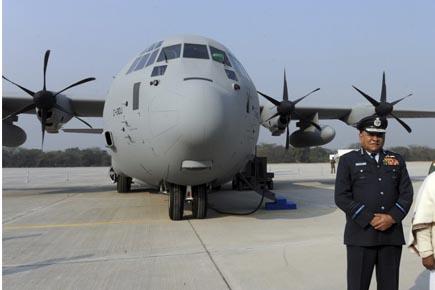Five armed forces personnel were killed when a newly-acquired C-130J transport aircraft crashed near Gwalior on Friday in what is seen as a major setback to the efforts of the Indian Air Force (IAF) to sharpen its tactical capabilities. The IAF described it as a said day but reiffrmed its commitment to its mission

New Delhi: Five armed forces personnel were killed when a newly-acquired C-130J transport aircraft crashed near Gwalior on Friday in what is seen as a major setback to the efforts of the Indian Air Force (IAF) to sharpen its tactical capabilities. The IAF described it as a said day but reiffrmed its commitment to its mission.

Indian Defence Minister A.K. Antony (R) and Chief of Indian Air Force Air Staff Air Marshal P.V. Naik (L) pose in front of the US manufactered C-130J Super Hercules on February 5, 2011. Pic: AFP
ADVERTISEMENT
"It is very unfortunate that we have lost five of our brave warriors in a tragic accident today. It is a sad moment for all of us and we share the grief with the family members," the IAF chief, Air Chief Marshal Subir Raha said, adding: "Events like these are painful reminders of the inherent risks which our brave airwarriors face in the execution of our daily mission."
"While the IAF will conduct a thorough enquiry into the accident to ascertain exactly what led to this accident, the IAF remains committed to provide the best possible equipment and training to our personnel so that they can execute their assigned missions professionally," an IAF statement said.
The victims have been identified as Wing commander P. Joshi, Wing Commander Raji Nair, Squadron Leader K. Mishra, Squadron Leader A. Yadav and Warrant Officer Krishna Pal Singh.
"The aircraft crashed 72 km west of Gwalior. It had taken off from Agra around 10 a.m. on a routine training mission," an IAF officer told IANS here earlier Friday.
The ill-fated multi-role plane, one of six acquired two years ago for Special Forces operations, was believed to be one of two engaged in a low-level tactical operation meant to evade radar while inducting troops behind "enemy" lines.
The C-130J, also known as the Super Hercules, sources said, had been used in tandem with an IAF P8I Poseidon maritime reconnaissance aircraft during the recent search for the missing Malaysian airliner MH 370.
Prior to this, it was used in relief operations after last June's Uttarakhand floods and for a landing at Daulat Beg Oldie near the border with China that the IAF is in the process of reactivating.
India bought the six aircraft in January 2008 for $1.2 billion and the manufacturer, Lockheed Martin, began deliveries in January 2011. The six aircraft were based at the Hindon air base in Ghaziabad near the national capital from February, 2011.
India subsequently placed an add-on order of another six C-130J that are to be based at Panagarh in West Bengal and will be used to support operations in the Andaman and Nicobar Islands and the Bay of Bengal. Panagarh is also the headquarters of a soon-to-be-raised mountain strike corps of the Indian Army.
Soon after the induction and in the aftermath of a severe 6.8 magnitude earthquake in the northeast in September 2011, the C-130J was among the first planes to fly to the nearest air base at Bagdogra in West Bengal, carrying relief supplies and National Disaster Management Force members within under three hours.
On Dec 12, 2011, the IAF simulated a piracy contingency at Campbell Bay in the Nicobar Islands, the furthermost island territory of India, based on an intelligence input that an Indian merchant ship had been hijacked and hostages taken.
The mission simulated launching of a Para Special Forces team into the area using C-130J as the airborne platform. During planning for the drill, the objective was found to be 3,500 nautical miles away and the route was fixed through Kolkata and Port Blair to the drop zone over Campbell Bay. The round trip would have required a staggering 12 hours of flying, an IAF officer said.
The C-130J that day performed a non-stop mission of 12 hours and three minutes without refuelling and completed the simulated mission with success, the official said.
The four-engined turboprop has a minimum crew of three comprising two pilots and a loadmaster. It can carry 64 fully-kitted troops and 20 tonnes of cargo.
It can touch speeds of 700 km.p.h and can take off from landing strips of about 1,000 metres.
The C-130J had made its debut at the 63rd Republic Day parade here January 26, 2012.
 Subscribe today by clicking the link and stay updated with the latest news!" Click here!
Subscribe today by clicking the link and stay updated with the latest news!" Click here!







